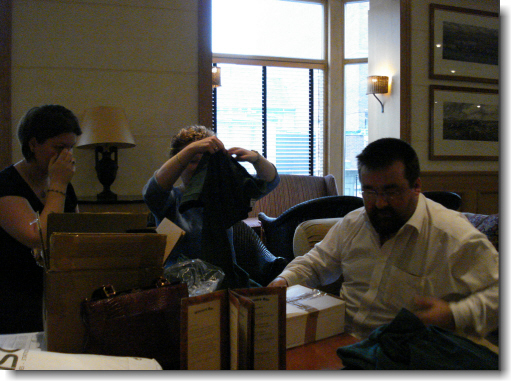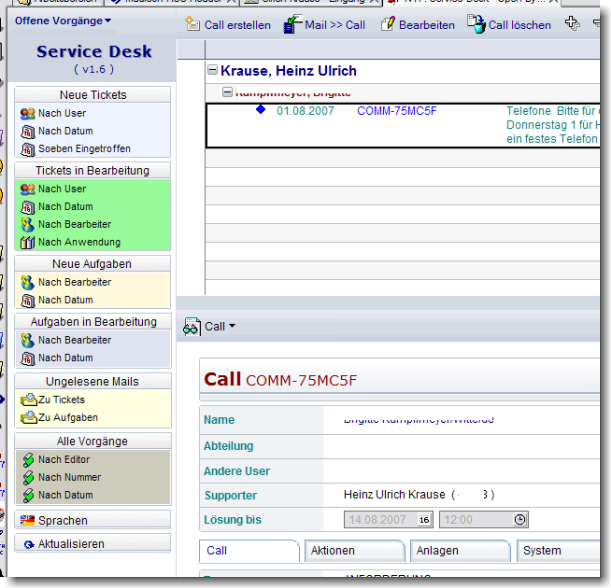Author: Ulrich Krause
YTRIA – Get Your Free Licence Keys
Based on the success of last year’s Summer Licence Key promotion, YTRIA decided to do it again!
Hurry up and get your free license keys for their awesome tools today!
Coming Soon – IdeaExchange
This site will not only allow the community to drive future features that they would like to see in Notes/Domino/Samtime/Quickr etc. but will also be for Lotus ISV’s as well. I have discussed this concept with a half dozen or so Lotus ISV’s in they welcome the approach that we are striving to deliver.
Bruce Elgort
[more …]
Gantt Charts in Notes Views – The Sequel
Several gurus of the Lotus Notes community ( like Chris Blatnick, Nathan Freeman, Theo Heselmans, Vitor Pereira, and to round it out Kevin Pettitt ) are working on Gantt Charts in Notes Views these days. Nathan Freeman also provided a sample database.
I’ve downloaded the sample and gave it a try. The first thing I found out is that it is not possible to display more than one month in a view because the “zeroDate” – value for the columns is calculated by stripping the last part of the view title and convert it into a DateTime value. The sideeffect of this method is that documents from a different month are displayed in the view but no chart is displayed for these documents.
OK, you can avoid this by setting the view selction formula properly. The second thing is that Nathan uses
zeroDate :=@TextToTime(@Right(@ViewTitle; "-"));
in each of the 62 view columns to calculate the date basis. Maybe a bit ressource performance consuming, isn’t it ?
So I decided to make a few modifications to address these issues. I created a new field in the task form ( “zeroDate”, Date/Time, calculated )
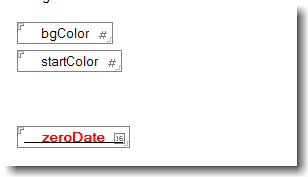
and assigned the following formula to the field:
@TextToTime("[01/"+ @Text(@Month(startDate)) +"/"+ @Text(@Year(startDate)) + "]" )
When you create a new task, the zeroDate field is now set to the first day of the month according to the start date’s month.
You can now delete the unnecessary code from the column formulas and reduce it to
col := 0;
colDate := @Adjust(zeroDate; 0; 0; col; 0; 0; 0);
@If(@Date(startDate) = @Date(coldate); duration; " ")
After adding two categorized columns ( one contains @Year(StartDate) and the other one @Month(StartDate) ) the view displays the charts for each month in a seperate category.
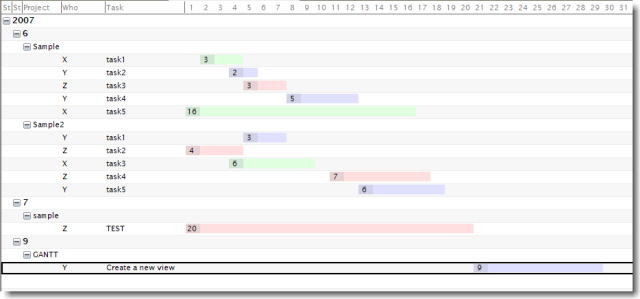
The view can have any name of your choice.
ReportGenerator Class
Andre Guirard presents a class for creating rich-text reports and displaying them in a few different ways. It includes code to deal with the problem of paragraphs getting too long, and conversely, the problem of having too many paragraphs.
Basically, when you want to have a line break in your report, the class only starts a new paragraph if you specify it has to. Otherwise it uses line break, unless the paragraph is getting too long, in which case it starts a new paragraph.
Calculate Elapsed Time Between Two Date/Time Values
For my OpenNTF project !!HELP!! I needed a function to calculate the elapsed time between two events. The code should be able to exclude holidays and weekends. In addition it should calculate the time difference only within workhours. Here is the result of a rainy sunday 🙂
There is another class by Sean Burgess, which does the same stuff than mine.
The following sample returns the amount of time in minutes between two given date/time values
Sub Click(Source As Button)
Dim startdt As String
Dim enddt As String
Dim dtc As New DateTimeCalculator ( "1,7","24.12.2007","7:00~17:00")
startdt = "18.06.2007 16:59"
enddt = "19.06.2007 07:01"
Msgbox dtc.GetElapsedTime(startdt,enddt)
End Sub
Copy the following code to a script library. Type
Use "YourLibName"
into the Options section of your button, agent or whereever you like to use the lib. Don’t forget to include Julian Robichaux’s OpenLog for error trapping.
Class DateTimeCalculator
Private StartDT As NotesDateTime
Private EndDT As NotesDateTime
Private dt3 As NotesDateTime
Private dt4 As NotesDateTime
Private dt5 As NotesDateTime
Private WDENDHOUR As String
Private WDSTARTHOUR As String
Private nondays As String
Private holidays As String
Sub New (strExcludeDays As String,strExcludeDates As String,SERVICEHOURS As String)
On Error Goto ERRHANDLE
WDSTARTHOUR = "00:00"
WDENDHOUR = "23:59"
nondays = "0"
holidays = "[01/01/1899]"
If SERVICEHOURS <> "" Then
WDSTARTHOUR = Strtoken(SERVICEHOURS,"~",1)
WDENDHOUR = Strtoken(SERVICEHOURS,"~",2)
End If
If strExcludeDays <> "" Then
nondays = Implode(Split(strExcludeDays,","),":")
End If
If strExcludeDates <> "" Then
holidays = Implode(Split(strExcludeDates,","),"]:[")
holidays = "[" & holidays & "]"
End If
EXITPOINT:
Exit Sub
ERRHANDLE:
Call LogError()
Resume EXITPOINT
End Sub
Public Function GetNextBusinessDay (dt1 As String) As String
On Error Goto ERRHANDLE
Dim newDT As Boolean
Set Me.StartDT = New NotesDateTime(dt1)
NewDt = False
Set dt3 = New NotesDateTime(Me.StartDT.DateOnly & " " & Me.WDSTARTHOUR)
Set dt4 = New NotesDateTime(Me.StartDT.DateOnly & " " & Me.WDENDHOUR)
If Me.StartDT.TimeDifference(dt3) < 0 Then ' StartDT < WDSTARTHOUR
Set Me.StartDT = dt3
End If
If dt4.TimeDifference(Me.StartDT) < 0 Then ' StartDT > WDENDHOUR
Set Me.StartDT = dt3
Call Me.StartDT.AdjustDay(1)
End If
While Me.GetBusinessDays (StartDT.DateOnly,StartDT.DateOnly ) = 0
Call StartDT.AdjustDay(1)
NewDT = True
Wend
If NewDT Then
Set dt5 = New NotesDateTime(Me.StartDT.DateOnly & " " & Me.WDSTARTHOUR)
Set Me.StartDT = dt5
End If
GetNextBusinessDay = Me.StartDT.LocalTime
EXITPOINT:
Exit Function
ERRHANDLE:
Call LogError()
Resume EXITPOINT
End Function
Private Function GetNumBusinessDayHours () As Integer
On Error Goto ERRHANDLE
Dim BDHOURS1 As New NotesDateTime(Today & " " & Me.WDSTARTHOUR)
Dim BDHOURS2 As New NotesDateTime(Today & " " & Me.WDENDHOUR)
GetNumBusinessDayHours = Fix(((BDHOURS2.TimeDifference(BDHOURS1)/60)Mod 1440)/60)
EXITPOINT:
Exit Function
ERRHANDLE:
Call LogError()
Resume EXITPOINT
End Function
Private Function GetTimeDifference (strStart As String,strEnd As String ) As Long
On Error Goto ERRHANDLE
Dim BDSTART As New NotesDateTime(strStart)
Dim BDEND As New NotesDateTime(strEnd)
GetTimeDifference = Fix((BDEND.TimeDifference(BDSTART)/60)Mod 1440)
EXITPOINT:
Exit Function
ERRHANDLE:
Call LogError()
Resume EXITPOINT
End Function
Public Function GetBusinessDays(dtStart As String,dtEnd As String) As Integer
On Error Goto ERRHANDLE
Dim busdays As Variant
Dim BDS As New NotesDateTime(dtStart)
Dim BDE As New NotesDateTime(dtEnd)
busdays = Evaluate(_
{@BusinessDays([}&_
Cdat(BDS.DateOnly)& {];[}&_
Cdat(BDE.DateOnly)& {];}&_
Me.nondays &{;}&_
Me.holidays & {)})
GetBusinessDays = Cint(busdays(0))
EXITPOINT:
Exit Function
ERRHANDLE:
Call LogError()
Resume EXITPOINT
End Function
Public Function GetElapsedTime (dtStart As String,dtEnd As String) As Long
On Error Goto ERRHANDLE
Dim intStart As Long
Dim intMiddle As Long
Dim intEnd As Long
Dim i As Integer
Set dt3 = New NotesDateTime(dtStart)
Set dt4 = New NotesDateTime(dtEnd)
If dt3.DateOnly = dt4.dateonly Then ' same day
GetElapsedTime = Me.GetTimeDifference(dtStart,dtEnd)
Else
intStart = Me.GetTimeDifference(dtStart,Cstr(dt3.DateOnly & " " & Me.WDENDHOUR))
intMiddle = 0
i = Me.GetBusinessDays(dtStart,dtEnd)-2
If i > 0 Then
intMiddle = (i*Me.GetNumBusinessDayHours())*60
End If
intEnd = Me.GetTimeDifference(Cstr(dt4.DateOnly & " " & Me.WDSTARTHOUR),dtEnd)
GetElapsedTime = intStart+intMiddle+intEnd
End If
EXITPOINT:
Exit Function
ERRHANDLE:
Call LogError()
Resume EXITPOINT
End Function
End Class
Adjust Date/Time To Next Business Day – Part II
In my recent posting I showed a method to calculate the number of business days between one date and another. It is possible to exclude weekends and a list of dates, too.
How to adjust Date/Time to next business day, I’ve already described here.
When using the GetBusinessDays method from my recent posting, the code to adjust a date to the next business day can be reduced to at least this snippet:
Sub Click(Source As Button)
Dim dtStart As String
Dim dtEnd As String
dtStart = Today
dtEnd = dtStart
Dim b As New BusinessDay("1:7","[18.06.2007]:[19.06.2007]:[20.06.2007]")
Dim StartDT As NotesDateTime
Set StartDT = New NotesDateTime (dtStart)
While b.GetBusinessDays (dtStart,dtEnd ) = 0
Call StartDT.AdjustDay(1)
dtEnd = StartDT.DateOnly
Wend
Msgbox StartDT.DateOnly
End Sub
This is a great example of how evaluating @formulas in LotusScript can save you a lot of time when you want to write a function which is not available in Script.
@BusinessDays In LS
In R6 you can use @BusinessDays to calculate the number of working days between one date and another, excluding non-working days and a list of dates to exclude as well. As there is no equivalent in LotusScript, I wrote a small class to simulate @BusinessDays in LS.
Actually I did not reinvent the wheel, but simply used evaluate in combination with @BusinessDays to achieve the aim.
Here is my code:
Class BusinessDay
Private holidays As String
Private nondays As String
Sub New (strExcludeDays As String,strExcludeDates As String)
holidays = "[01/01/1899]"
nondays = "0"
If strExcludeDays <> "" Then
nondays = strExcludeDays
End If
If strExcludeDates <> "" Then
holidays = strExcludeDates
End If
End Sub
Public Function GetBusinessDays(dtStart As String,dtEnd As String) As Integer
Dim bd As Variant
Dim StartDT As New NotesDateTime(dtStart)
Dim EndDT As New NotesDateTime(dtEnd)
GetBusinessDays = 0
bd = Evaluate({@BusinessDays([}&_
Cdat(StartDT.DateOnly)& {];[}&_
Cdat(EndDT.DateOnly)& {];}&_
Me.nondays &{;}&_
Me.holidays &_
{)})
GetBusinessDays = Cint(bd(0))
End Function
End Class
To test the code, put the code into the declaration section of a button. In your “Click” event type
Sub Click(Source As Button)
Dim dtStart As String
Dim dtEnd As String
dtStart = "05.06.2007"
dtEnd = "11.06.2007"
'Dim b As New BusinessDay("1:7","[08.06.2007]:[06.06.2007]:[07.06.2007]")
'Dim b As New BusinessDay("","[08.06.2007]:[06.06.2007]:[07.06.2007]")
Dim b As New BusinessDay("","")
Msgbox b.GetBusinessDays (dtStart,dtEnd )
End Sub
SuperNTF – Beta 0.9.4 released
Kevin Pettitt released version 0.9.4 of SuperNTF on OpenNTF.
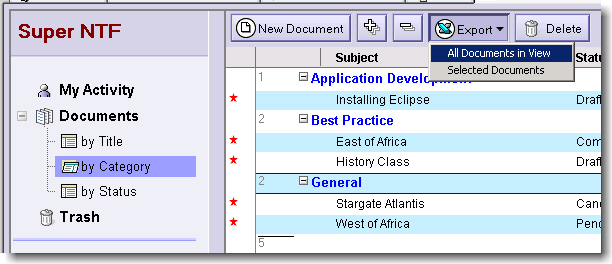
The initial release of SuperNTF is full of goodies. The first thing you will see is the clean navigation framework. Give yourself the “Admin” role and you will see a link to the “Administration” panel, where all sorts of configuration and logging functions are visible.
You should click the “DB Config” item under “Configuration” to change some global database properties. Check out the other configuration options, and note the “code helpers” which build formula syntax for using keyword and other formulas automatically.
I highly recommend keeping soft deletions enabled, as it works VERY well, regardless of how you delete documents (including “cuts”). Also note the mouseover behavior of the trash icon (and several others).
If you write any agents, check out the “Agent Templates” which provide a couple different common agent frameworks. Note that these samples include the standard OpenLog error trapping elements.
The standard “view actions” are highly tuned to show/hide as appropriate. E.g. the “Search” button only shows if the db is full text indexed. Also visible (only on windows) are the excel export actions.
All read and edit activity is tracked, so if you want to know what you looked at yesterday, check the “My History” view. To see what your boss read yesterday, look in the “User Activity” views in the Administration section. You can also see the history of specific field value changes at the document level.
And much more…
Adjust Date/Time To Next Business Day
Finding the difference in seconds between one date-time and another can be done using the timedifference method of the NotesDateTime class in LotusScript. In formula language, @BusinessDays returns the number of business days in one or more date ranges.
Assume you have the following requirements:
- Calculate the time in minutes between “DateCreated” and “DateClosed”.
- Businessdays are from Monday to Friday
- BusinessHours ar from 8 AM to 10 PM
- Exclude holidays
- If the date/time value is greater than the end of a businessday, set date to next businessday
- if the date/time value is before the beginning of a businessday, set the time to i.e 8 AM
Here is a LotusScript class which does the trick.
Class DateTimeCalculator
Private StartDT As NotesDateTime
Private EndDT As NotesDateTime
Private dt3 As NotesDateTime
Private dt4 As NotesDateTime
Private dt5 As NotesDateTime
Private NewDT As Boolean
Private tmp As Variant
Private i As Integer
Private j As Integer
Private k As Integer
Private x As Integer
Private elapsed As Integer
Private ExcludeDays() As String
Private ExcludeDates() As NotesDateTime
Private WDENDHOUR As String
Private WDSTARTHOUR As String
Sub New (strExcludeDays As String_
, strExcludeDates As String_
, strWDSTARTHOUR As String_
, strWDENDHOUR As String)
If strWDSTARTHOUR = "" Then
WDSTARTHOUR = "00:00"
Else
WDSTARTHOUR = strWDSTARTHOUR
End If
If strWDENDHOUR = "" Then
WDENDHOUR = "23:59"
Else
WDENDHOUR = strWDENDHOUR
End If
' strExcludeDays contains a comma separated list of dayes that are not work days
tmp = Split(strExcludeDays,",")
Redim Me.ExcludeDays(Ubound(tmp))
For x = 0 To Ubound(tmp)
Me.ExcludeDays(x) = tmp(x)
Next
' strExcludeDates contains a comma separated list of dates that are not work days
tmp = Split(strExcludeDates,",")
Redim Me.ExcludeDates(Ubound(tmp))
For x = 0 To Ubound(tmp)
Set Me.ExcludeDates(x) = New NotesDateTime(tmp(x))
Next
End Sub
Public Function GetNextBusinessDay ( dt1 As String )As String
Set Me.StartDT = New NotesDateTime (dt1)
NewDt = False
Set dt3 = New NotesDateTime (Me.StartDT.DateOnly & " " & Me.WDSTARTHOUR)
Set dt4 = New NotesDateTime (Me.StartDT.DateOnly & " " & Me.WDENDHOUR)
If Me.StartDT.TimeDifference(dt3) < 0 Then ' StartDT < WDSTARTHOUR
Set Me.StartDT = dt3
End If
If dt4.TimeDifference(Me.StartDT) < 0 Then ' StartDT > WDENDHOUR
Set Me.StartDT = dt3
Call StartDT.AdjustDay(1)
End If
For j = 0 To Ubound ( Me.ExcludeDates ) ' Check for excluded dates
For k = 0 To Ubound ( Me.ExcludeDates )
If Me.StartDT.DateOnly = Me.ExcludeDates(k).DateOnly Then
Call Me.StartDT.AdjustDay(1)
NewDT = True
For i = 0 To Ubound ( Me.ExcludeDays ) ' Check if businessday
If Instr(Implode ( Me.ExcludeDays )_
, Cstr(Weekday(Me.StartDT.DateOnly))) > 0 Then
Call Me.StartDT.AdjustDay(1)
End If
Next
k = Ubound(Me.ExcludeDates)
Else
For i = 0 To Ubound ( Me.ExcludeDays ) ' Check if businessday
If Instr(Implode ( Me.ExcludeDays _
), Cstr(Weekday(Me.StartDT.DateOnly))) > 0 Then
Call Me.StartDT.AdjustDay(1)
NewDT = True
End If
Next
End If
Next
Next
If NewDT Then
Set dt5 = _
New NotesDateTime (Me.StartDT.DateOnly & " " & Me.WDSTARTHOUR)
Set Me.StartDT = dt5
End If
GetNextBusinessDay = Me.StartDT.LocalTime
End Function
End Class
This class has a New function that is used to instantiate the class. A list of business days, list of holidays and the start and end of the workday is passed when the object is created.
Dim DTCalc As New DateTimeCalculator ( "1,7", "11.06.2007","08:00", "22:00")
Once instatiated you can now adjust a date/time value to the next business by calling the GetNextBusinessDay method and passing the date/time value as a string parameter.
StartDT = doc.GetFirstItem("DateCreated").text
...
Set dt1 = New NotesDateTime ( DTCalc.GetNextBusinessDay(StartDT) )
The returned value can now be used to find the difference between this date/time value and another one.
diff = dt2.TimeDifference(dt1)/60
Here is an example of how to put this all together in a click button. I have attached a sample database at the end of this article.
Sub Click(Source As Button)
Dim s As New NotesSession
Dim db As NotesDatabase
Dim col As NotesDocumentCollection
Dim doc As NotesDocument
Set db = s.CurrentDatabase
Set col = db.UnprocessedDocuments
Set doc = col.GetFirstDocument
Dim msg As String
Dim StartDT As String
Dim EndDT As String
Dim dt1 As NotesDateTime
Dim dt2 As NotesDateTime
Dim diff As Long
StartDT = doc.GetFirstItem("DateCreated").text
EndDT = doc.GetFirstItem("DateClosed").text
Dim DTCalc As New DateTimeCalculator ( "1,7", "11.06.2007","08:00", "22:00")
Set dt1 = New NotesDateTime ( DTCalc.GetNextBusinessDay(StartDT) )
Set dt2 = New NotesDateTime ( DTCalc.GetNextBusinessDay(EndDT) )
diff = dt2.TimeDifference(dt1)/60
msg = msg & "Created On : " & StartDT & CRLF
msg = msg & "Closed On : " & EndDT & CRLF
msg = msg & "Difference : " & diff & " minutes"
Msgbox msg
End Sub
!!HELP!! and ExtND
Today I built in the ExtND framework into the !!HELP!! database. Without digging to deep into the framework, I was able to create a simple web interface for the helpdesk. Unfortunately, the framework does not support categorized views at the moment.

But this doesn’t matter. It is an Alpha release. But it already produces nice looking grid views with navigation and stuff. and works as expected in Firefox and IE.
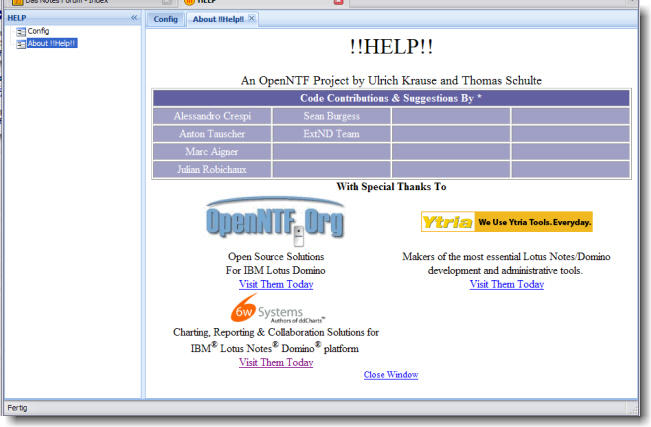
The next release of !!HELP!! will include the ExtND framework along with a handful of views and forms to enable end-users to watch the progress of their service calls on the web.
I would like to thank all who contributed to the !!HELP!! project. If you, as an end-user, would like to write a testimonial, you can do so here
OpenNTF Blast
The best in Open Source on OpenNTF, See the presentation from last week’s ILUG conference in Dublin by Kevin Pettit, Bruce Elgort and Vince Schuurman.
More slideshows tagged with ILUG2007
Ext.nd – Initial Release
Initial Release of Ext.nd is available for download.
Ext.nd aims to develop a framework that will extend Domino, based on EXT to provide an easy to use, well structured, well documented, tool that will yield a highly finished product in a matter of days, not weeks.
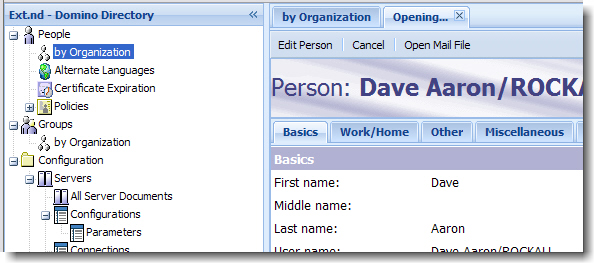
Screenshot taken from http://openntf.org/extnd/names.nsf/main.html
ILUG2007 – Geek Stuff
Here are 2 must-have tools for real Lotus Notes and Domino geeks. 🙂
Kevin Pettitt announces SuperNTF in his OpenNTF Blast! session at ILUG2007. SuperNTF is a framework for developers who do not want to start a new database ( or application in Notes/Domono 8 ) from scatch. SuperNTF will be available for download on OpenNTF site after Kevin returns home from Dublin.
The Day Before ILUG2007
Just returned from the lobby of the Alexander Hotel in Dublin, Ireland. Loads of geeks already there from mostly the U.S.A and Canada. Attached you find a photo taken while Kitty, Eileen and a Scotsman named Bill preparing some secret stuff for tomorrows event.
